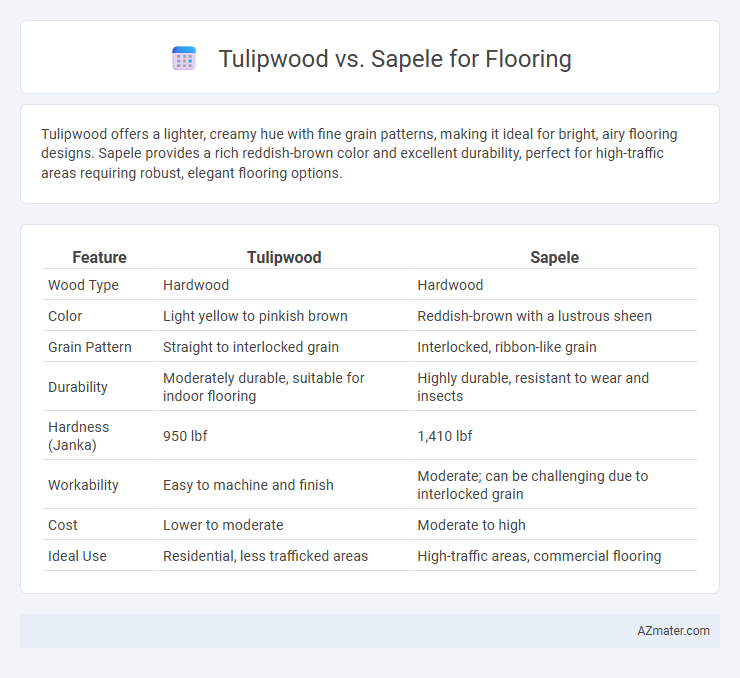Tulipwood offers a lighter, creamy hue with fine grain patterns, making it ideal for bright, airy flooring designs. Sapele provides a rich reddish-brown color and excellent durability, perfect for high-traffic areas requiring robust, elegant flooring options.
Table of Comparison
| Feature | Tulipwood | Sapele |
|---|---|---|
| Wood Type | Hardwood | Hardwood |
| Color | Light yellow to pinkish brown | Reddish-brown with a lustrous sheen |
| Grain Pattern | Straight to interlocked grain | Interlocked, ribbon-like grain |
| Durability | Moderately durable, suitable for indoor flooring | Highly durable, resistant to wear and insects |
| Hardness (Janka) | 950 lbf | 1,410 lbf |
| Workability | Easy to machine and finish | Moderate; can be challenging due to interlocked grain |
| Cost | Lower to moderate | Moderate to high |
| Ideal Use | Residential, less trafficked areas | High-traffic areas, commercial flooring |
Introduction to Tulipwood and Sapele Flooring
Tulipwood flooring offers a light, warm tone with subtle grain patterns that enhance modern and traditional interiors, prized for its durability and resistance to wear. Sapele flooring features a rich reddish-brown hue with a distinctive interlocking grain, providing exceptional hardness and a luxurious aesthetic suitable for high-traffic areas. Both woods are sustainable choices with excellent stability, making them ideal for long-lasting and visually appealing flooring solutions.
Botanical Origins and Tree Sources
Tulipwood, derived from the Liriodendron tulipifera tree native to eastern North America, features a light, creamy-yellow color with subtle greenish hues and a fine, straight grain. Sapele originates from the Entandrophragma cylindricum tree found in tropical Africa, displaying a rich reddish-brown tone with a distinctive interlocking grain pattern. Both hardwoods offer durable flooring options, with Tulipwood prized for its lighter appearance and Sapele favored for its darker, more dramatic aesthetic.
Physical Appearance and Grain Patterns
Tulipwood flooring features a light, creamy yellow to light pink hue with subtle, straight grain patterns that create a smooth and uniform surface ideal for modern interiors. In contrast, Sapele flooring boasts a rich reddish-brown color with interlocking grain patterns producing a striking, wavy, or ribbon-like texture that adds depth and character. The distinct coloration and grain complexity of Sapele make it a preferred choice for homeowners seeking a warm, elegant aesthetic, while Tulipwood offers a brighter, more understated look.
Color Variations and Aging Over Time
Tulipwood flooring exhibits a range of colors from creamy yellow to warm brown with occasional darker streaks, offering a dynamic and vibrant appearance that can brighten spaces. Sapele flooring features rich reddish-brown hues that darken and deepen with age, developing a luxurious patina and enhancing character over time. Tulipwood tends to lighten and mellow with exposure to sunlight, while Sapele's aging process results in a gradual darkening, making both woods unique choices depending on desired color evolution in flooring.
Hardness, Density, and Durability
Tulipwood offers a Janka hardness rating of around 830, making it moderately hard and suitable for flooring with a density of about 510 kg/m3, while Sapele boasts a higher Janka hardness of approximately 1,410 and a density near 640 kg/m3. This increased hardness and density make Sapele more resistant to dents and wear, enhancing its durability under heavy foot traffic. Tulipwood tends to be softer and less dense, providing a warmer look but requiring more maintenance compared to the robust and long-lasting qualities of Sapele flooring.
Workability and Installation Considerations
Tulipwood offers moderate workability with a fine, even texture, making it relatively easy to cut and shape during flooring installation, while its lighter weight reduces handling effort. Sapele features a more interlocked grain and higher density, which can challenge cutting and nailing but ensures greater durability and stability once installed. Installation of Tulipwood may require fewer specialized tools and adhesives compared to Sapele, which benefits from pre-drilling and moisture control to prevent expansion and warping.
Maintenance and Lifespan of Floors
Tulipwood flooring offers moderate durability with a lifespan of around 20-30 years, requiring regular maintenance such as polishing and cleaning to prevent scratches and wear. Sapele flooring is harder and more durable, lasting up to 40 years with proper care, and is more resistant to dents and moisture, making it easier to maintain with occasional refinishing. Both woods require controlled indoor humidity levels to maximize lifespan and maintain structural integrity.
Environmental Impact and Sustainability
Tulipwood flooring is typically sourced from fast-growing trees native to North America, offering a more renewable option with a lower carbon footprint compared to Sapele, which originates from slower-growing tropical African trees and often raises concerns about deforestation and habitat loss. Sapele, while durable and visually appealing, is frequently harvested in regions with less stringent environmental regulations, increasing the risk of unsustainable logging practices. Choosing Tulipwood supports sustainable forestry initiatives and reduces the environmental impact associated with transportation and resource depletion.
Cost Comparison and Market Availability
Tulipwood generally costs less than Sapele, making it a budget-friendly option for flooring projects, while Sapele's higher price reflects its durability and rich, reddish-brown hue. Sapele is more widely available in global markets due to its export volume from West Africa, whereas Tulipwood, harvested primarily in the southeastern United States, has limited availability and seasonal supply constraints. Flooring professionals often choose Sapele for high-end projects requiring longevity and aesthetic warmth, while Tulipwood suits cost-sensitive applications with moderate foot traffic.
Pros and Cons: Making the Right Choice
Tulipwood flooring offers a lighter color palette and a smooth, fine grain, making it ideal for bright, modern interiors but tends to be softer and less durable than Sapele. Sapele provides greater hardness and resistance to dents, with a rich reddish-brown hue and pronounced grain patterns, suitable for high-traffic areas though it may darken over time. Choosing between Tulipwood and Sapele depends on balancing aesthetic preferences with durability needs and maintenance considerations.

Infographic: Tulipwood vs Sapele for Flooring
 azmater.com
azmater.com